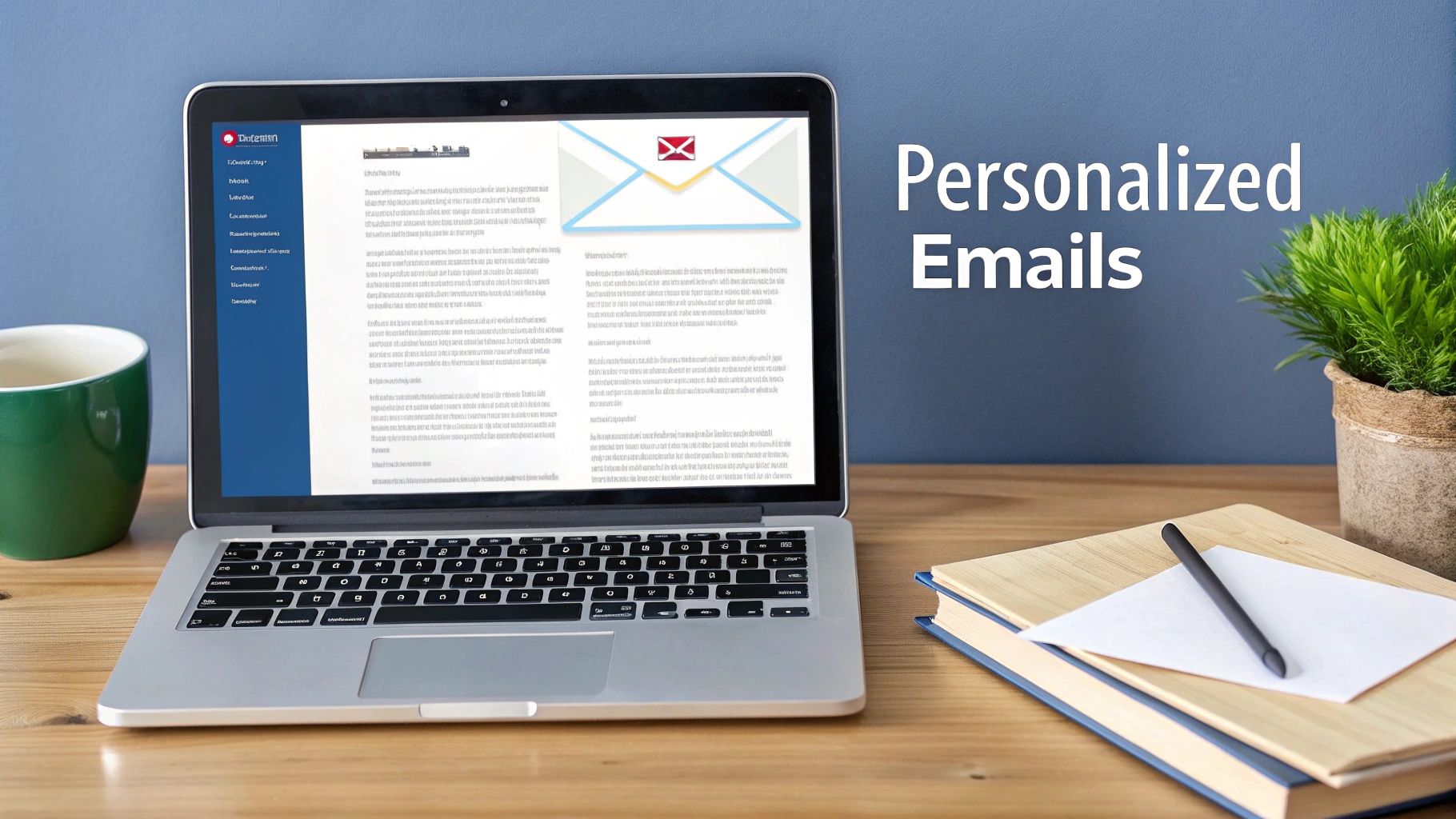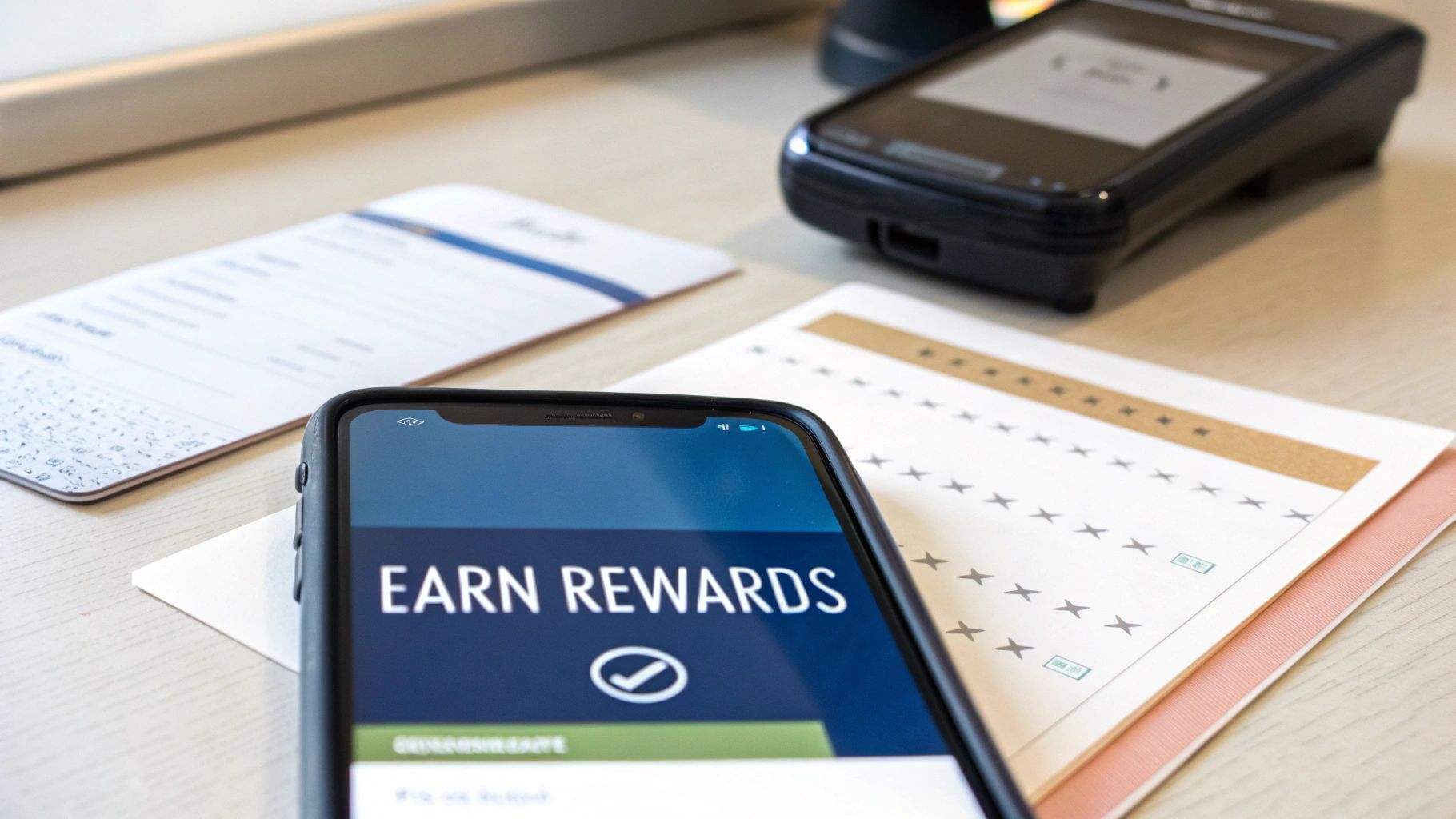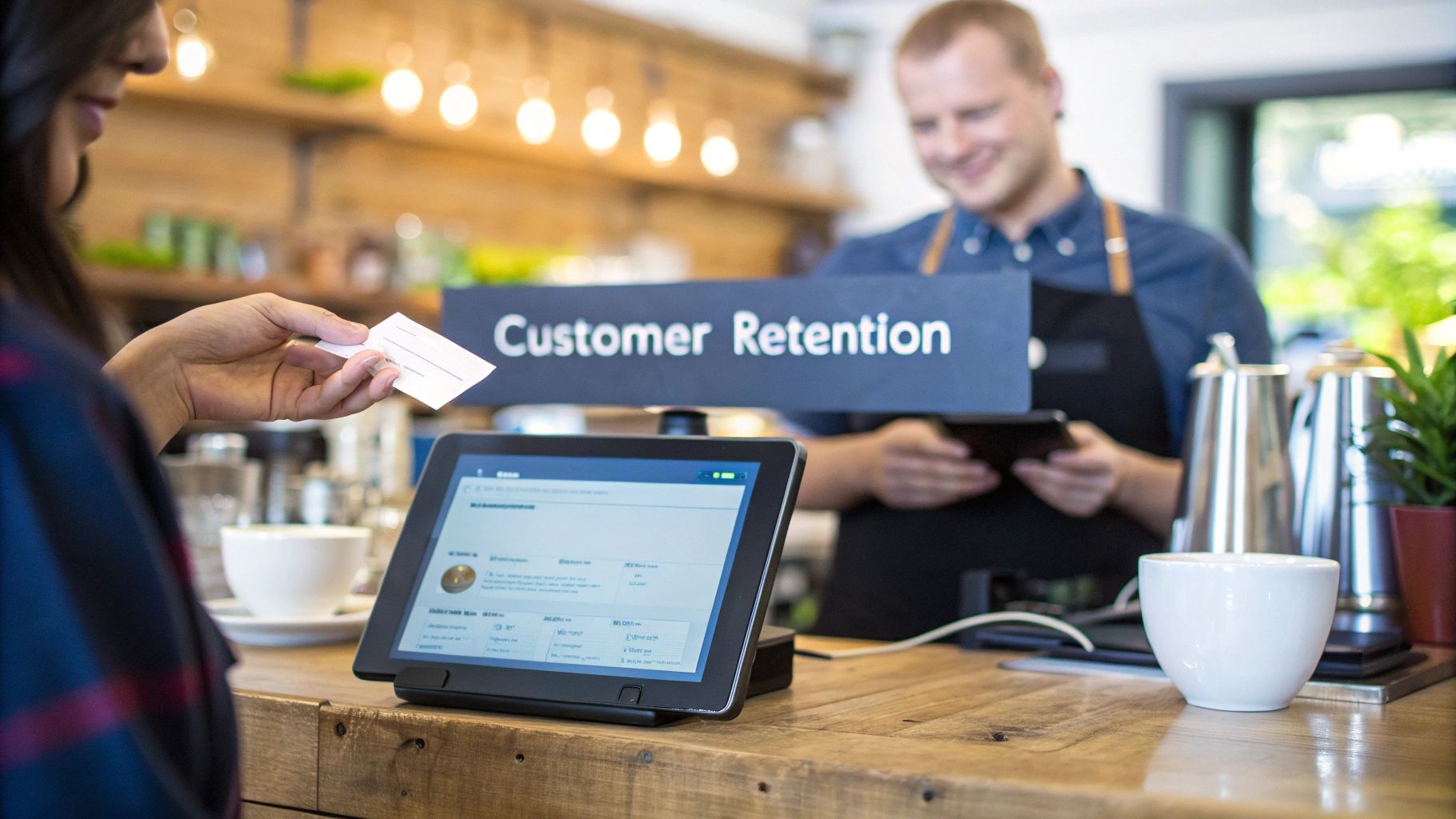In the competitive landscape of 2025, acquiring a new customer is 5 to 25 times more expensive than retaining an existing one. For small businesses, this isn't just a statistic; it's a lifeline. While attracting new clients is exciting, building a sustainable, profitable business hinges on your ability to turn first-time buyers into lifelong fans. True growth comes from nurturing the relationships you've already built, creating a stable revenue base that fuels expansion and innovation.
This guide moves beyond generic advice to provide a deep dive into 8 powerful customer retention strategies for small business that you can implement immediately. We will explore actionable tactics, real-world examples, and the specific tools you can use to transform customer satisfaction into a predictable engine for growth. From crafting personalized email campaigns that resonate with individual needs to implementing robust loyalty programs that reward repeat business, each strategy is designed for maximum impact with minimal resources.
You will learn how to build a thriving community around your brand, use proactive communication to anticipate customer needs, and create a feedback loop that drives continuous improvement. To understand the fundamental value of these systems, consider exploring the importance of loyalty systems for small businesses as a cornerstone of growth. This comprehensive list provides the framework you need to foster genuine loyalty, reduce churn, and ensure your business not only survives but thrives. Let's dive into the strategies that will turn your existing customers into your most valuable asset.
1. Personalized Email Marketing Campaigns
Personalized email marketing is a powerful customer retention strategy that moves beyond generic, one-size-fits-all newsletters. It leverages customer data like purchase history, browsing behavior, and personal preferences to deliver highly relevant and customized content directly to their inbox. This tailored approach makes customers feel seen and valued, strengthening their connection to your brand and encouraging repeat business.
Instead of sending the same promotion to everyone, you send messages that resonate with each individual's specific needs and interests. This method is fundamental to modern customer retention strategies for small business owners because it nurtures relationships at scale, turning one-time buyers into loyal advocates.

Why It Works for Retention
Personalization transforms your email from a simple advertisement into a valuable service. When a local bookstore sends reading recommendations based on a customer's favorite authors, it's not just selling; it's acting as a personal literary curator. This level of customized attention builds trust and makes customers eager to see what you'll offer next, significantly reducing the likelihood they'll switch to a competitor.
Key Insight: According to McKinsey, 71% of consumers expect companies to deliver personalized interactions, and 76% get frustrated when this doesn’t happen. Failing to personalize is no longer a missed opportunity; it's a competitive disadvantage.
How to Implement It
Getting started with personalized email marketing is more accessible than ever, even for a small team. Here are actionable steps to take:
- Start with Simple Segmentation: Begin by grouping your audience into basic segments. Common starting points include new customers, repeat buyers, and inactive subscribers. You can create unique welcome series for the first group and re-engagement campaigns for the last.
- Utilize Dynamic Content: Use merge tags to automatically insert a customer's first name into the subject line and greeting. You can also reference their most recent purchase or a product they viewed, creating an immediate sense of familiarity.
- Automate Triggered Emails: Set up automated emails based on customer actions. For example, a pet supply store can send a reorder reminder 30 days after a customer buys a bag of dog food. Similarly, a coffee shop can automate a birthday email offering a discount on the customer's favorite drink. These automated touchpoints keep your brand top-of-mind. To further enhance this immediate, personalized communication, you can explore how marketing chatbots complement these strategies.
- Test and Optimize: Don't guess what works best. A/B test your subject lines, send times, and calls-to-action to see what generates the highest engagement from your specific audience. Always ensure your emails are optimized for mobile devices, as that's where a majority of your audience will read them.
2. Customer Loyalty and Rewards Programs
A customer loyalty program is a structured incentive system that rewards customers for repeat purchases and ongoing engagement. These programs encourage continued patronage by offering tangible value, such as points, discounts, or exclusive perks, that customers earn as they continue to do business with you. This creates a psychological commitment that increases customer lifetime value and builds a moat against competitors.
For a small business, this strategy turns transactional purchases into a long-term relationship. It gives customers a compelling reason to choose you over a competitor, even if a slightly better price is available elsewhere. This approach is a cornerstone of effective customer retention strategies for small business owners because it formalizes appreciation and gamifies brand loyalty.

Why It Works for Retention
Loyalty programs tap into the basic human desire for recognition and reward. When a customer sees their points balance grow or unlocks a new tier, they feel a sense of progress and achievement connected to your brand. A local coffee shop’s simple "buy 10, get 1 free" punch card creates a mini-goal that keeps customers returning. This added value makes customers feel appreciated and less sensitive to price, fostering a durable connection that transcends individual transactions.
Key Insight: Research from Bond Brand Loyalty found that 79% of consumers say loyalty programs make them more likely to continue doing business with brands. Furthermore, 66% of consumers modify their spending to maximize loyalty benefits, directly impacting your revenue.
How to Implement It
Launching a loyalty program doesn't have to be complex or expensive. Modern tools make it accessible for any small business. Here are actionable steps to get started:
- Keep It Simple and Achievable: Start with a straightforward system. A points-per-dollar program or a simple punch card is easy for both customers and staff to understand. Ensure the first reward is attainable quickly to create momentum and demonstrate the program's value from the outset.
- Offer Valuable, Brand-Aligned Rewards: The rewards should be desirable to your customers and reflect your brand. A beauty salon could offer a free product or an upgraded service, while an independent bookstore might provide exclusive access to an author event. Mix discounts with experiential rewards that can't be bought.
- Promote It Actively: A loyalty program only works if customers use it. Train your staff to promote enrollment at the point of sale. Clearly communicate benefits on your website, in-store signage, and through email marketing. Regularly update members on their points balance and progress toward the next reward.
- Leverage Program Data: Use the purchasing data collected from your loyalty program to understand customer behavior better. A pizza restaurant, for example, can identify its most popular items and offer double points on slower days to help balance demand and drive incremental visits.
3. Exceptional Customer Service and Support
Exceptional customer service is a cornerstone of customer retention strategies for small business owners, transforming routine interactions into memorable, loyalty-building experiences. It’s about consistently exceeding expectations at every touchpoint, whether a customer has a simple question or a complex problem. By being responsive, empathetic, and solution-oriented, you create an emotional connection that transcends price and convenience.
This approach gives small businesses a powerful competitive advantage against larger, less personal corporations. When a customer feels genuinely cared for, they are far more likely to return and recommend your business to others, turning great service into sustainable growth.

Why It Works for Retention
Outstanding service builds an emotional bank account with your customers. When a mistake inevitably happens, a history of positive, helpful interactions provides a strong foundation of goodwill, making customers more forgiving and willing to stick with you. A local hardware store that offers free, expert advice isn't just selling tools; it's becoming a trusted partner in its customers' projects.
This proactive, supportive relationship makes customers feel secure in their choice to do business with you. It shifts their perception from a transactional one to a relational one, making them significantly less likely to be swayed by a competitor’s discount.
Key Insight: According to research by HubSpot, 93% of customers are likely to make repeat purchases with companies that offer excellent customer service. This highlights the direct link between support quality and long-term loyalty.
How to Implement It
Creating a culture of exceptional service is achievable for any small business. Here are concrete steps to get started:
- Empower Your Team: Give your frontline staff the autonomy to solve customer problems on the spot. Ritz-Carlton famously gives employees a discretionary budget of up to $2,000 to resolve guest issues without needing a manager's approval.
- Be Responsive and Accessible: Make it easy for customers to contact you and aim to respond to all inquiries within 24 hours, or even faster for urgent matters. Prominently display your contact information on your website and social media.
- Personalize Every Interaction: Use the customer's name and reference past conversations or purchases. This small detail shows you see them as an individual, not just a transaction number. A boutique hotel that remembers a guest's pillow preference is a prime example of this in action.
- Master Service Recovery: When things go wrong, apologize sincerely, take ownership, and overcompensate to fix the problem. Turn negative feedback into a public demonstration of your commitment by responding to reviews with helpful solutions. For a deeper dive, you can explore more customer support best practices.
- Follow Up: After an issue is resolved, send a follow-up message to ensure the customer is completely satisfied. This final touch reinforces your dedication to their happiness and leaves a lasting positive impression.
4. Community Building and Engagement
Community building is a customer retention strategy that transforms your brand from a simple provider of goods or services into a central hub for shared interests and values. It focuses on fostering connections between customers themselves, as well as between customers and your business. This creates a powerful sense of belonging that transcends transactional relationships.
For small businesses, this is an exceptionally effective approach because it turns customers into invested members who feel part of something bigger. By creating a tribe around your brand, you build deep-rooted loyalty that is difficult for competitors to replicate, making it one of the most powerful customer retention strategies for small business owners.

Why It Works for Retention
A strong community provides value beyond your core product or service. When a local bookstore hosts a monthly book club, it's not just selling books; it's creating a space for literary discussion and friendship. Customers return not just for the product but for the experience and the relationships they've built. This emotional investment makes them far more likely to remain loyal and advocate on your behalf.
Key Insight: A CMX survey found that 86% of companies believe that having a branded online community has a positive impact on their business objectives, with 66% stating it improves customer retention.
How to Implement It
Building a community doesn't require a massive budget, just a commitment to authentic engagement. Here are some actionable steps to get started:
- Create a Dedicated Space: Establish a place where your customers can connect. This could be a private Facebook group, a Slack channel, a Discord server, or even a dedicated forum on your website. The key is to give them a "home base."
- Host Regular Events: Consistency is crucial for momentum. Host regular online or in-person events like workshops, Q&A sessions, or customer meetups. A local CrossFit gym, for example, thrives on the tight-knit community built through daily workouts and social events.
- Empower Your Members: Identify your most passionate customers and make them community ambassadors or moderators. Encourage user-generated content by sharing their stories, photos, or reviews. When customers feel ownership, their loyalty deepens.
- Provide Exclusive Value: Offer community-only perks, such as early access to new products, exclusive content, or special discounts. This reinforces the value of being a member and makes them feel like insiders.
- Participate Authentically: A community manager or business owner must be an active participant. Answer questions, join discussions, and ask for feedback on business decisions. This shows you value their presence and opinions, solidifying their connection to your brand.
5. Proactive Customer Communication and Check-ins
Proactive customer communication is a retention strategy focused on reaching out to customers before they encounter problems or have a reason to leave. It involves scheduled check-ins, educational content, and milestone celebrations to show you are invested in their success. This approach shifts the dynamic from reactive problem-solving to proactive relationship-building, demonstrating genuine care and anticipating customer needs.
Instead of waiting for a customer to call with a complaint, you initiate contact to ensure they are getting the most value from your product or service. For a small business, this personal touch is a powerful differentiator, creating strong, loyal relationships that larger competitors often struggle to replicate. This makes it a cornerstone among effective customer retention strategies for small business owners.
Why It Works for Retention
Proactive outreach makes customers feel supported and valued, not just like another transaction. When an auto repair shop sends a reminder that a customer's vehicle is due for an oil change based on their typical mileage, it provides a helpful service that builds trust and prevents a future maintenance issue. This level of foresight strengthens the customer relationship, keeps your business top-of-mind, and significantly reduces churn by addressing potential dissatisfaction before it even arises.
Key Insight: According to research by Envesp, 56% of customers feel more loyal to brands that "get them." Proactive communication demonstrates a deep understanding of the customer's journey and needs, reinforcing this feeling of being understood.
How to Implement It
Building a proactive communication plan is achievable for any small business. The key is to be systematic and genuine in your outreach. Here are actionable steps to get started:
- Map the Customer Lifecycle: Create a communication calendar based on key customer milestones. For a SaaS company, this could mean check-in calls at 30, 60, and 90 days post-signup. For an HVAC company, it means scheduling seasonal system tune-up reminders.
- Leverage Your CRM: Use a Customer Relationship Management (CRM) tool to track all interactions and set automated reminders for check-ins. This ensures no customer falls through the cracks and that your outreach is timely and relevant.
- Provide Consistent Value: Ensure every communication offers something valuable, whether it's a usage tip, a relevant article, or a simple, genuine question about their experience. An accountant could reach out quarterly to review business performance, not just at tax time.
- Automate Where It Makes Sense: Use automation for routine touchpoints like anniversary messages or maintenance reminders. This frees up your team for more personalized, high-impact conversations. Discover how to automate customer service to handle initial inquiries and schedule these proactive check-ins efficiently.
- Listen and Document: During check-ins, ask open-ended questions about the customer's goals and challenges. Document their feedback in your CRM to personalize future interactions and show you were listening. A follow-up that references a previous conversation is incredibly powerful for building rapport.
6. Customer Feedback Loop and Continuous Improvement
A customer feedback loop is a systematic process of collecting, analyzing, and acting on customer input to continually enhance your products, services, and overall experience. This strategy transforms customer feedback from a passive suggestion box into an active, engine-driving improvement. It involves not only listening to what customers say but also visibly implementing their suggestions and communicating those changes back to them.
This approach is one of the most powerful customer retention strategies for small business owners because it makes customers feel like valued partners. By showing them their voice directly shapes your business, you build a deep sense of loyalty and investment that competitors find nearly impossible to replicate. It turns customers into stakeholders who are genuinely rooting for your success.
Why It Works for Retention
Implementing a feedback loop demonstrates that you respect and value your customers' opinions beyond just their transactions. When a software company adds a feature requested by users or a local restaurant introduces a menu item based on customer polls, it sends a powerful message: "We're listening, and you matter." This collaborative relationship builds trust and makes customers feel a sense of ownership, making them far more likely to stick around long-term.
Key Insight: According to a report by Microsoft, 52% of people around the globe believe that companies need to take action on feedback provided by their customers. Closing the loop is a direct response to this expectation and a key differentiator.
How to Implement It
Creating an effective feedback loop doesn't require a massive budget, just a commitment to listening and responding. Here are practical steps to get started:
- Ask for Feedback at Key Moments: Don't wait for customers to come to you. Proactively request feedback at strategic points in their journey, such as immediately after a purchase, following a customer support interaction, or after a new feature launch.
- Keep It Simple and Accessible: Make providing feedback effortless. Use short, 3-5 question surveys, one-click rating emails, or simple text-back polls. The easier it is to respond, the higher your completion rates will be.
- Centralize and Analyze Feedback: Use a simple spreadsheet or a dedicated tool to gather all feedback in one place. Categorize it by theme (e.g., product features, customer service, pricing) to identify recurring patterns and prioritize action items.
- Close the Loop and Communicate Changes: This is the most crucial step. Publicly acknowledge the feedback you've received. Send out a quarterly "What we've heard and what we're doing" newsletter or post updates on social media. When you implement a specific customer's suggestion, reach out to them personally to say thank you. This single action can create a lifelong advocate for your brand.
7. Value-Added Content and Education
Value-added content and education is a customer retention strategy that shifts your business from a simple vendor to a trusted advisor. It involves creating and sharing valuable, relevant, and consistent content that helps customers solve problems, achieve goals, and get more value from your products or services. This approach builds authority and keeps your brand top-of-mind between transactions.
Instead of only promoting your products, you provide expertise through how-to guides, industry insights, workshops, and webinars. For small businesses, this is a powerful way to cultivate loyalty by investing in your customers' success. A local garden center that offers seasonal planting guides isn't just selling seeds; it's empowering customers to become better gardeners, ensuring they return for advice and supplies.
Why It Works for Retention
This strategy transforms the customer relationship from transactional to collaborative. By consistently providing useful information without an immediate sales pitch, you build significant trust and reciprocity. Customers come to see your business as an indispensable resource, not just a place to buy things. This deepens their loyalty far more than discounts ever could.
Key Insight: Popularized by thought leaders like Marcus Sheridan in his book They Ask, You Answer, the core principle is simple: if your customers have questions, you should be the one to answer them. This builds trust and positions you as the go-to expert in your field, making it difficult for competitors to lure your customers away.
How to Implement It
Integrating educational content into your marketing doesn't require a large budget, just a commitment to helping your customers. Here are some actionable steps:
- Answer Customer Questions: Start by creating content that answers the most common questions your sales and support teams receive. This could be a blog post, a short video tutorial, or a detailed FAQ page. This foundational step is one of the most effective customer retention strategies for small business owners.
- Focus on Customer Goals: Develop content that helps customers succeed in their own endeavors. A financial advisor could create a newsletter with weekly market insights, while a bike shop could host free basic maintenance workshops. The focus is on their benefit, not your product's features.
- Repurpose Content Across Channels: Be efficient with your efforts. Turn a comprehensive blog post into a series of social media tips, a checklist, and a short video. To effectively provide value and educate your customers, consider these content marketing best practices to maximize your reach.
- Maintain a Consistent Schedule: Whether it's a weekly newsletter, a monthly webinar, or a bi-weekly blog post, consistency is key. A content calendar helps you plan ahead and ensures your audience knows when to expect new valuable information from you. This regular contact keeps your brand present in their minds.
8. Subscription and Membership Models
Subscription and membership models transform transactional relationships into long-term partnerships by converting one-time purchases into predictable, recurring revenue streams. This approach hardwires retention into your business model, as success depends entirely on keeping customers engaged and subscribed month after month. Instead of constantly chasing new sales, you focus on delivering continuous value to a loyal base.
This model makes it incredibly convenient for customers to stay with you, whether through auto-delivery of essential products or exclusive access to content and perks. For a small business, implementing this is a powerful customer retention strategy because it creates a stable financial foundation and shifts your focus from acquisition to satisfaction, fostering deep, ongoing connections.
Why It Works for Retention
The subscription model inherently combats customer churn by making loyalty the path of least resistance. When a local coffee shop offers a monthly plan for unlimited drip coffee, it becomes the customer's default choice every morning. This creates a high switching cost, not just financially but also in terms of convenience and habit. The value isn't in a single transaction; it's in the consistent, reliable service that integrates your brand into the customer's daily life.
Key Insight: According to Zuora's Subscription Economy Index, subscription-based companies have grown over 3.7 times faster than S&P 500 companies over the past decade. This growth is fueled by the model's ability to create predictable revenue and foster lasting customer relationships.
How to Implement It
Launching a subscription or membership program is a strategic way to lock in loyalty. Here are practical steps to get started:
- Offer Tiered Options: Create multiple subscription levels to cater to different needs and budgets. A car wash, for example, could offer a basic exterior-only plan and a premium plan that includes interior detailing and waxing.
- Provide Flexibility and Control: Reduce cancellations by allowing subscribers to easily pause, skip a delivery, or customize their order. This empowerment builds trust and accommodates changing customer needs without forcing them to churn completely.
- Create Subscriber-Only Perks: Make members feel special by offering exclusive benefits they can't get otherwise. This could be early access to new products, members-only discounts, exclusive content, or an invitation to a private community group.
- Communicate Proactively: Prevent "surprise" cancellations by sending automated reminders before a subscription renews or a new order ships. This transparency is crucial for maintaining a positive customer experience and is a cornerstone of effective customer retention strategies for small business owners.
Customer Retention Strategies Comparison
| Strategy | Implementation Complexity 🔄 | Resource Requirements ⚡ | Expected Outcomes 📊 | Ideal Use Cases 💡 | Key Advantages ⭐ |
|---|---|---|---|---|---|
| Personalized Email Marketing Campaigns | Medium (requires data management & automation) | Low to Medium (email platform costs) | Measurable ROI, scalable engagement | E-commerce, retail, small businesses needing targeted outreach | High ROI, scalable, automated personalization |
| Customer Loyalty and Rewards Programs | Medium to High (depends on program complexity) | Low to High (platforms & rewards costs) | Increased purchase frequency, retention | Retail, food & beverage, service industries | Boosts repeat purchases, referral generation |
| Exceptional Customer Service and Support | High (training & process-intensive) | Medium to High (training & policy costs) | Strong emotional bonds, reduced churn | All businesses valuing differentiation via service | Builds loyalty, premium pricing possible |
| Community Building and Engagement | High (time and consistency needed) | Low to Medium (mainly time, event costs) | Deep emotional investment, organic growth | Lifestyle brands, niche markets, local businesses | Creates loyal advocates, insightful feedback |
| Proactive Customer Communication and Check-ins | Medium (requires CRM & schedule management) | Low to Medium (CRM, staff time) | Early issue resolution, increased satisfaction | Service businesses, B2B, subscription models | Prevents churn, increases adoption |
| Customer Feedback Loop and Continuous Improvement | Low to Medium (survey systems, analysis) | Low (survey tools) | Actionable insights, increased loyalty | All industries, especially competitive & evolving markets | Direct customer insights, innovation driver |
| Value-Added Content and Education | Medium to High (content creation investment) | Low to Medium (production costs) | Authority building, long-term engagement | Complex products/services, B2B, education-driven sectors | Establishes expertise, attracts & retains customers |
| Subscription and Membership Models | High (operational & billing infrastructure) | Medium to High (subscription platforms & fulfillment) | Predictable revenue, higher lifetime value | Consumables, services, content access, convenience sectors | Recurring revenue, natural retention focus |
Start Building Your Customer Loyalty Flywheel Today
We've explored a comprehensive suite of powerful customer retention strategies for small business, moving from personalized email campaigns and loyalty programs to the foundational importance of exceptional service and community building. Each strategy, from proactive communication and robust feedback loops to value-added content and subscription models, represents a vital cog in the machinery of sustainable growth. The journey from a first-time buyer to a lifelong advocate is not accidental; it is a direct result of intentional, consistent, and authentic engagement.
The core lesson is this: customer retention isn't a single project with a start and end date. It is an operational philosophy, a continuous commitment that should be woven into the very fabric of your business. It’s the friendly follow-up email, the surprise discount for a loyal patron, the quick resolution of a support ticket, and the genuine appreciation you show for feedback, whether it's glowing or critical. These seemingly small actions compound over time, transforming transactional relationships into deeply rooted loyalty.
From Strategy to Action: Your Next Steps
The sheer number of options can feel overwhelming, but progress begins with a single, deliberate step. Don't attempt to implement all eight strategies at once. Instead, adopt a focused, incremental approach to build momentum.
- Assess and Prioritize: Review the strategies discussed. Which one or two align most naturally with your current business model and resources? A consultant might prioritize a feedback loop, while an e-commerce store could see immediate returns from a loyalty program.
- Set a Clear Goal: What does success look like? Aim to increase your customer lifetime value (CLV) by 15% in the next six months, or reduce your churn rate by 5%. A specific, measurable goal will keep your efforts on track.
- Implement and Measure: Launch your chosen initiative. Whether you're using email marketing software to track open rates on personalized campaigns or a simple survey tool to gather feedback, data is your best friend. Track your key metrics closely to understand what’s working and what isn’t.
- Iterate and Expand: Based on the results, refine your approach. Once your first initiative is running smoothly and showing positive results, consider adding a second, complementary strategy. This is how you build a powerful, self-reinforcing loyalty flywheel.
The True ROI of Retention
Investing in these customer retention strategies for small business delivers returns far beyond a healthier bottom line. It builds a resilient brand fortified by a community of advocates who not only keep buying but also become your most effective marketing channel. They are the ones who will leave positive reviews, refer friends and family, and defend your brand in public forums. This organic word-of-mouth marketing is invaluable, building a level of trust and credibility that no advertising budget can buy.
Ultimately, focusing on retention shifts your business from a constant, costly hunt for new leads to a more profitable and fulfilling model of nurturing existing relationships. It’s about creating a business that people don’t just buy from, but that they genuinely want to see succeed. By making your existing customers feel seen, heard, and valued, you are not just preventing churn; you are building a legacy of loyalty and a foundation for enduring success.
Ready to automate and enhance your customer interactions? Many of the strategies discussed, like providing exceptional 24/7 support and gathering instant feedback, can be streamlined with AI. Explore ChatbotGen to build a custom AI chatbot that can handle inquiries, engage users, and improve your customer retention efforts around the clock.
